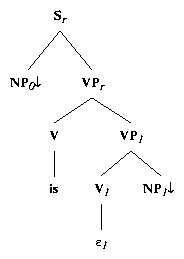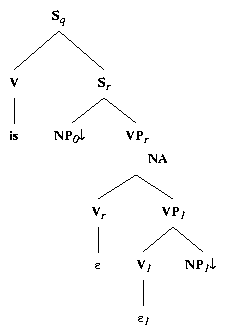

In addition, the subject and complement can exchange positions in these type of examples but not in sentences with predicative be. Sentence ((109)) has the same interpretation as sentence ((104)) and differs only in the positions of the subject and complement NP's. Similar sentences, with a predicative be, are shown in ((110)) and ((111)). In this case, the sentence with the exchanged NP's ((111)) is ungrammatical.
The non-predicative be in ((103)) and ((104)), also called EQUATIVE BE, patterns differently, both syntactically and semantically, from the predicative usage of be. Since these sentences are clearly not predicative, it is not desirable to have a tree structure that is anchored by the NP, AP, or PP, as we have in the predicative sentences. In addition to the conceptual problem, we would also need a mechanism to block raising verbs from adjoining into these sentences (while allowing them for true predicative phrases), and prevent these types of sentence from being embedded (again, while allowing them for true predicative phrases).
 |
 |
|
| (a) | (b) |
Although non-predicative be is not a raising verb, it does exhibit the auxiliary verb behavior set out in section 9.1.1. It inverts, contracts, and so forth, as seen in sentences ((112)) and ((113)), and therefore can not be associated with any existing tree family for main verbs. It requires a separate tree family that includes the tree for inversion. Figures 9.8(a) and 9.8(b) show the declarative and inverted trees, respectively, for equative be.